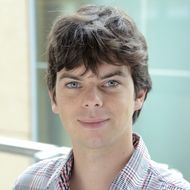- A
- A
- A
- ABC
- ABC
- ABC
- А
- А
- А
- А
- А
Nature Communications Journal Publishes a Study by Russian Scholars Involving HSE MIEM Students
© iStock
Biologists and mathematicians from HSE University, Skoltech and the RAS Kharkevich Institute have studied the spread of COVID-19 in Russia. The main part of the study was completed in late June, but until October, the team was working with data following the reviewers’ recommendations. The paper was published on January 28, 2021 in the journal Nature Communications. MIEM students spoke about their contribution to the research.
The Essence of the Study
A team of researchers from HSE University and Skoltech joined experts from the Smorodintsev Research Institute of Influenza in St. Petersburg and the Kharkevich Institute to carry out a study aimed at determining when the pandemic started in Russia and where the virus came from. They compared 211 coronavirus mutations from patients in 25 Russian regions and used them to build evolutionary trees of the virus. They discovered that SARS-SoV-2 was brought to Russia from Europe between late February and early March 2020. The first case of its transmission inside the country happened no earlier than March 11, 2020.
MIEM Students’ Work in the Research
Vadim Spirin and Nikita Shvyrev, second-year students of Applied Mathematics, work as research interns at the HSE International Laboratory of Statistical and Computational Genomics. Supervised by Vladimir Shchur, the Lab’s director, the students joined the research project in late April 2020. SARS-CoV-2 had only just appeared at the time, and there was almost no data on it, which made it particularly interesting for them to take on this project.
The students evaluated different parameters of coronavirus spreading at Vreden Hospital in St. Petersburg, where over 700 people were locked down in a quarantine for a month and over 400 of them were infected. The hospital provided a vast amount of unique data on the infected patients for the study, including the results of the virus RNA sequencing in these patients. The job was done in several stages. At first, the students sorted out the necessary software, read scholarly papers on similar tasks and looked at different models of virus distribution. Then, they applied this knowledge to solve their tasks.

Vadim Spirin,
research intern at the HSE International Laboratory of Statistical and Computational Genomics
We understood that it was important not to make a mess at the initial stage, so we listened to Professor Shchur carefully. Our task was to quickly find the necessary information for research progress and study papers with similar studies in order to take advantage of other scholars’ experience. Most skills that we needed for the job we mastered in the process of doing it. I learned to work with BEAST2, to quickly scan papers for necessary information, and to work with big information volumes in general.
To study the data, the researchers used BEAST2 pack, especially the Birth–Death skyline model. BEAST2 is a program that helps to build a distribution tree, as well as to calculate the start of virus spreading, the speed of virus mutations, and many other parameters based on the virus’s nucleotide sequences. In addition, they used software such as FigTree, which allows different presentations of the results to be created in order to see the trees, and Tracer to see the calculated parameters. The students used BEAST2 pack on the HSE supercomputer to speed up their calculations.

Nikita Shvyrev,
research intern at the HSE International Laboratory of Statistical and Computational Genomics
I am completely satisfied with what we have done. Thanks to my work on the project, I met a lot of professionals in this area and saw what real project work looks like. The most difficult thing was not to miss classes and to prepare for exams, since all I wanted to do was work on the research 24/7.
While the working pace was extremely rapid for the students, the research turned out to be thrilling, and thanks to their participation in it, they now have a clearer vision of their goals and priorities. Vadim Spirin admits that when he was entering the university he thought he only had to learn Python programming language. But as he started working on projects, he understood that its extreme deficiencies for high-quality work.
‘I have to learn to work with Cython, git, bash-scripts and С++/С. And even this may not be enough, since I may need knowledge in other areas, as well as knowledge of Python and C++/C libraries, in order to create more efficient algorithms,’ the student said. This means they now have a lot of tasks for the future.

Vladimir Shchur,
Head of the HSE International Laboratory of Statistical and Computational Genomics
I like working together with students on research projects. While I formulate the task for them and try to express myself in a comprehensible way, I start seeing the project details much more clearly. I also love it when students ask me questions. They often admit that they are afraid to appear stupid. But actually, asking questions is their primary responsibility. Someone who doesn’t know and doesn’t understand anything can’t ask questions. Furthermore, no one can know everything, and only those who ask can grow and develop. A good question from a student sometimes allows me to look at the problem from a new perspective and realize that I had missed something or mistakenly thought it was obvious.
The article was prepared by Valeria Nemnaya, second-year student at MIEM HSE